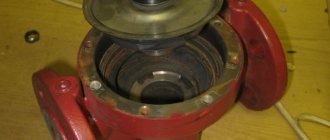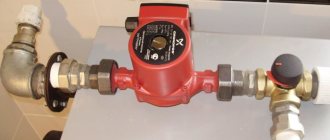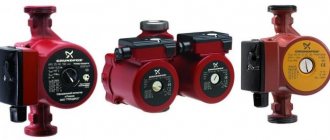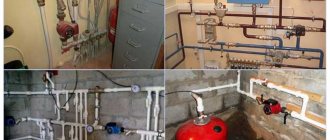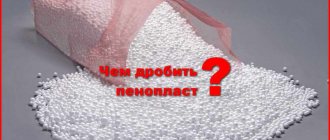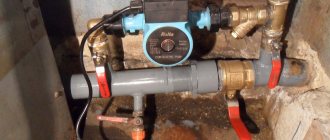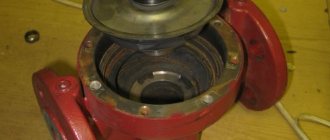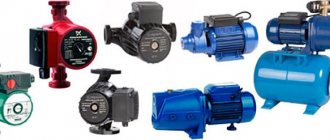From the author: Hello, dear readers! The circulation pump plays a very important role in the heating system of almost any private home. Without this device, the coolant flows through the pipeline at a very low speed, resulting in significant wasted thermal energy losses. The result is an unevenly heated house and the danger of freezing of pipes located in non-residential premises - in the attic, basement, etc.
The circulation device easily prevents the mentioned problems. It increases the speed of the coolant flow, thereby giving the liquid the opportunity to quickly run along the route and deliver the required amount of heat to all radiators and other similar equipment. Naturally, to perform this function efficiently, the device must work flawlessly. That's why every homeowner should know how to test a heating circulation pump.
As you know, timely diagnostics can detect a malfunction even in the early stages of development, so a preventive inspection will help protect the device from possible serious damage. The nice thing is that performing the check will not take much of your time and effort, and almost any owner can handle the necessary repairs. Of course, to do this you need to have some information - and you can get it from today's article.
Operating rules
To prevent breakdowns, follow the operating rules:
- It is prohibited to operate the house heating pump if there is no water in the system;
- do not use the unit at zero supply;
- During operation, feed limits are observed;
- to prevent oxidation during downtime, the unit must be turned on for fifteen minutes;
- the temperature of the working fluid does not exceed sixty-five degrees Celsius;
- no leaks at pipe connections;
- no heating of the unit;
- Do-it-yourself pump installation involves horizontal placement of the shaft.
If the rules are followed, the unit can last ten years.
Design
Almost all circulation pumps are centrifugal type. They have an impeller mounted on the motor shaft and placed in a special “shell” chamber. The entrance to the shell is located in the center, while the exit is the outer edge of the shell with a channel extending around the circumference in the direction of movement of the impeller. The engine spins the impeller, and water, under the influence of centripetal force, rushes from the center to the edges of the sink from inlet to outlet.
Pump structural elements:
- pump part, sink and impeller mounted on the shaft;
- electric motor;
- electronic control unit.
The most susceptible to wear is the moving part of the pump - the motor shaft and impeller, as well as the bearings on which they are mounted.
Breakdowns and troubleshooting methods
Depending on the problem, the cause of the breakdown and its elimination are determined:
Circulation pump device for heating
- The circulation pump does not turn on and does not make noise. The reason is a burned out winding or a broken fuse. The fuse or winding is changed;
- When the unit is turned on, a hum is heard, but the shaft does not rotate. Why does the unit hum but not work? Most likely, during prolonged inactivity, oxidation of the shaft occurred. If the device is blocked, it is disconnected from the network. The screws connecting the engine and the housing are unscrewed. The motor is removed and the shaft is turned. For low-power units, the shaft is unlocked using a screwdriver;
- The pump turns off after it is turned on without starting to work. The reason is scale between the stator and rotor. After dismantling the engine, salt deposits are removed;
- During operation, the device begins to heat up. Why does the engine get hot? There are several reasons for heating. Incorrect installation, poorly lubricated bearing, low mains voltage, system clogging. To eliminate the voltage problem, an uninterruptible power supply (UPS) is installed for the heating pump. A UPS is used for continuous power supply and protection against power surges. In the absence of electricity in the network, the UPS will ensure the operation of the unit for fifteen minutes (used as a power source). The UPS will protect the pump motor in the event of a surge, sudden drop or fluctuation in the voltage in the network. By connecting a UPS, the heating system will be protected from power surges. Mains power will be safe;
- food problem. The compliance of the actual voltage in the network with that specified in the characteristics is checked;
- the impeller is blocked. To troubleshoot the problem, you need to know how to disassemble the device. To eliminate the breakdown, the wheel is dismantled and the foreign object is removed. To prevent reoccurrence of blocking, a filter is installed at the pump inlet;
- When turned on, the pump may hum. The reason is accumulated air. To fix the problem, you need to bleed the air from the system. Automatic air vents will constantly bleed air. An air vent is needed to bleed air during operation and startup of the system;
- The unit vibrates during operation. The reason is bearing wear. The bearing needs to be replaced. The second reason is a clogged filter. The filter needs to be washed and cleaned;
- after switching on, the electric motor protection is activated. The reason is the engine electrics. It is necessary to contact a specialist;
- The water pressure is lower than specified in the technical specifications. We made a mistake while installing the device. Found in three-phase types of equipment.
Do-it-yourself heating pump repair (video)
Prevention of breakdowns
To prevent breakdowns, you need to check the serviceability of the heating pump yourself. Before the heating season begins, the unit is checked for breakdowns.
- Check for lubrication. When the pipes dry out, lubricate them.
- Check that the device is connected to the network correctly. When planning the heating system, it is necessary to place the pump in front of the boiler. This measure will reduce the formation of air jams to zero.
- The equipment is checked using a tester for correct connection to the network.
- Cleaning the filter from dirt.
- Before starting the heating, the equipment is tested. To pressurize the heating system, water or air is supplied to the system. For crimping, a hydraulic or pneumatic pump is used.
The influence of the crimping process on the injection mechanism
The pressure testing process ensures high-quality maintenance of the entire heating system.
In order for the entire system to operate without leaks and turn on without problems, this procedure is carried out. The procedure is carried out after disconnecting the system from the network and removing the coolant. Before the procedure, the pipes must be pressed (cleaned) of scale. Scale, deposited on the internal parts of the pipes, reduces their permeability by fifty percent, increasing the load on the supercharger. It will become difficult for the pump to pump water through the system and it will quickly fail. Circulation will be disrupted throughout the entire system. Heating will not be effective.
If the heating system is not pressurized once every five years, the centrifugal pump will not cope with its task.
How to properly disassemble the unit?
If problems are detected and corrected in the heating system, the equipment must be disassembled. To properly disassemble the unit, the following rules must be observed:
- The pump is disconnected from the network. When the pump is inserted into the heating system, a bypass pipe is installed. During operation, the pipe is switched off. During repairs, an auxiliary pump is connected. Installing a pump ensures the continued functioning of the heating.
- The valves are unscrewed and the unit is removed.
- The cover of the device is bolted to the body. During prolonged use, the pump heats up and the bolts stick to the housing, making it impossible to unscrew them. Liquid key aerosol solves the problem. It is applied to the bolt and after ten minutes it can be easily unscrewed.
- To access the interior, the housing cover is removed. The rotor, wheel and blades are unscrewed.
- Inspects and makes repairs with your own hands.
How to disassemble a heating circulation pump with your own hands
To repair the circulation pump, it is necessary to dismantle it and disassemble it thoroughly.
Initially, the device must be disconnected from the electrical network. To disconnect the cable from the terminal box, you must remove the housing from the device's power supply. Then you need to shut off the water supply through the side valves and drain the remainder in the system. Next, you need to unscrew the pump with a hex screwdriver.
You may encounter a problem when the bolts are stuck. They need to be moistened with WD-40 and after 20-30 minutes try to unscrew them again.
After dismantling is completed, it is necessary to remove the cover of the device. Below it is a rotor with a wheel and blades. You need to remove the rotor, which is usually secured with bolts. This will give you easy access to the internal parts of the pump. Then you should carefully inspect the device and troubleshoot any problems.
Summarizing all of the above, it is worth noting once again that the circulation pump is a very important element of the heating system, which is assigned serious functions. That is why it is very important to monitor its operation and carry out regular maintenance. In the event of malfunctions and malfunctions, you need to immediately take the necessary measures, otherwise you can start and your unit will simply fail.
Operating principle
The manufacturer uses metal to make the Baxi combustion chamber. On the outside it is covered with a layer of heat insulation. Above it there is a heat exchanger, which is made of copper. When there is a change in temperature in the room, the thermostat turns on. Please note that the launch is carried out automatically. From it the signal to turn on is transmitted to the pump. The latter creates a vacuum in the return pipeline. After this, heated water begins to flow into the heating system line under a pressure not exceeding 0.45 bar.
The boiler starts at low power. It gradually increases until the temperature of the coolant increases to a given value. After this, the mode changes - from heating to modulation mode . When the coolant temperature decreases, a signal is received from the temperature sensor, which leads to the opening of the inlet valve. After this, ignition occurs, and then the water is heated again.
If already at the beginning of the boiler operation its power is quite high, then the burner is switched off automatically. After three minutes, you can restart the system.
If there is no need for heating the room, then the boiler is turned on in DHW mode. In this case, cold water enters the secondary circuit through a three-way valve, through which the heating line is closed. supplied to the burner through a gas valve , which leads to a gradual increase in boiler power. After heating the water, the temperature control mode is activated.
Preventive examination
In order for the operation of the circulation pump to be problem-free, it is necessary to regularly check the condition of the equipment. A preventive inspection will help identify negative factors that can lead to serious breakdowns in the future. Their timely elimination will allow you to avoid force majeure situations and complex repair procedures.
A standard inspection includes a few simple steps:
- checking the tightness of connections. It is necessary to carefully inspect all fittings with which the pump is attached to the heating system. Some types of connecting elements may become loose over time and must be tightened. In addition, problems may arise with the destruction of the thread or seal - in this case, you need to unscrew the fitting, cut additional turns or wind a new layer of FUM tape, and then reassemble the element,
- adding lubricant. There are bearings inside the device that must be well lubricated. Otherwise, they will work worse, which will lead to overheating of the device,
- cleaning the filter. The mesh element gradually becomes clogged with dirt, even if you use a very high-quality coolant. Therefore, it is necessary to promptly remove rust and scale particles stuck in the filter.
Actually, this is a basic set of actions that need to be performed for prevention. In addition, you should follow some rules for operating the circulation pump:
- Avoid dry running. The pump should only be turned on if the required amount of coolant is present in the heating system. Equipment running “dry” will burn out very quickly, and may even drag down some other electrical appliances,
- Avoid prolonged idle time. In many regions, the heating system operates in seasonal mode - from September to May. It is clear that there is no point in launching it in thirty-degree heat. But if left idle for such a long time, some elements of the circulation pump may fail. Therefore, it must be turned on at least once a month for a quarter of an hour. Agree, it takes a little time, but it will help to avoid possible problems in the future,
- initially purchase a pump whose characteristics fully correspond to the needs of your heating system. It happens that owners, in an attempt to save money, buy a low-power device and try to use it in a system with a large volume of coolant. As a result, the device constantly works at the limit of its capabilities and, of course, fails very quickly. That is why it is important to make advance calculations of the parameters that you should focus on when purchasing. You can find information on how to do this on our portal,
- provide for overheating and “dry running” sensors. These regulators are not available on all models, but it is advisable to find and purchase a device with them. You may not immediately notice the problem on your own. For example, if there is a coolant leak in the system, then until you detect it, the pump will run idle and may simply burn out. And the sensor will react instantly, automatically turning off the equipment, and thereby preventing breakdown.
Inspection of the pump mechanism
In addition to contamination, the main cause of breakdown of the pumping mechanism is long-term dry operation. Due to the lack of liquid, the centrifugal impeller blocks get very hot and sinter, so the only repair option is to replace them. The situation is similar with the auger and landing bushings. Also, with jammed impellers, the shaft can rotate in the mounting holes, and in powerful pumps, it can become deformed and even destroyed.
In screw pumps, screws and landing bushings are consumables; they are replaced every 3–5 years, depending on the intensity of use. The main reasons are the natural aging of elements and exposure to small abrasive particles.
Screw and bushing for auger pump
Let us draw your attention to the fact that the parts of borehole pumps have a high precision of fit, thanks to which the cleaned mechanism is easily assembled and disassembled. If during assembly the parts do not fit into place freely, then the order of installation of the elements is incorrect. Different pump models have specific design differences, but basic recommendations for self-repair and disassembly for inspection purposes are always described in the user manual, which often includes an assembly diagram.
Leak prevention measures
The oil seal requires regular maintenance; maintenance should only be carried out by qualified personnel. Maintenance personnel must periodically inspect the seals, inspect the shaft journal, and check the tightening force. The disadvantage of cuffs is their limited scope of application.
For these reasons, manufacturers of pumping equipment are gradually switching from oil seals and cups to mechanical seals. They are more durable, suitable for pumping any materials in a wide variety of conditions, and do not require such careful maintenance throughout their service life.
The type of seal and material of the friction pair are selected based on the properties of the pumped liquid, operating temperature and pressure, and shaft rotation speed. The pump must be used to pump only those liquids for which the equipment is designed. The release of hazardous materials poses a serious threat to others.
Replacing the repair kit
Replacing the circulation apparatus repair kit includes:
- disassembling the pump part of the device;
- replacement of components;
- checking engine operation;
- device assembly;
- diagnostics of equipment operation.
Some manufacturers offer ready-made repair kits for pumping equipment. For example, a repair kit for a circulation pump u4814 with a capacity of 5200 l/h, voltage 12/24 V and a pipe diameter of 38 mm. Purchasing such a kit will reduce the waste of time and money.
Air removal scheme
You should repair the circulation device yourself only after the warranty period has expired or if it is impossible to call a repair specialist. Some pump components are difficult to find on the open market, which is explained by the trade policies of the manufacturing companies.
Revision of the motor part
Deep well pumps are equipped with a single-phase, mostly brushless induction motor. The connection diagram contains a starting capacitor. The stator of the electric motor has a monolithic attachment to the housing; it is often filled with epoxy compound.
In pumps of a monolithic design, the motor must be squeezed out of the glass by pressing on the connection outlet of the outgoing pipeline with the impellers removed. In rod pumps, the motor part is disconnected when the two halves are separated, in screw pumps - after removing the working screw. In all cases, the insides of the engine (capacitor, connecting terminals) can only be accessed after removing the sealed plug. It is fixed with 2-3 screws on the side surface of the sleeve and a powerful locking ring. In some types of pump, the plug may require the use of a special puller.
Well pump motor stator
All well pump motors are filled with oil, which performs lubricating, cooling and dielectric functions. The oil used is special food grade, but it is commercially available. Signs of low quality may be a cloudy color of the oil when mixed with water, darkening or the presence of mechanical impurities, as well as insufficient levels. If the oil is normal, it should be drained into a clean, dry container, leaving the motor housing for 15–20 minutes until the residue completely drains from the walls. Insufficient oil filling of the engine indicates wear of the oil seals.
In addition to spoiled oil, engine malfunctions can be caused by worn bearings, which can be determined by play and free-wheeling noise. If the pump has been operated for a long time under extreme conditions, the shaft may be bent (twisted) and the winding insulation may overheat. Burnt stators are practically beyond repair, but they are quite easy to replace.
Burning of the stator winding due to water entering the motor
What to do to stop noise from appearing
You can prevent the occurrence of extraneous sounds in the heating system at the project stage:
Modern circular pumps are very powerful. The productivity of the simplest silent unit is enough to maintain a comfortable temperature in a low-rise building. Proper installation, carried out according to the manufacturer’s instructions, will significantly improve the operation of the pump.
It is important to remember that the rotor of the wet type model is installed only horizontally. An error will lead to noise and rapid wear of parts. A coarse filter installed in front of the pump will prevent sand and small debris from entering. If you are unsure about the operating parameters of the system, you should choose a model with the ability to change the operating mode.
The permissible heating temperature of the coolant is 65 °C. The circular pump is mounted on a pipe that delivers cooled water to the boiler.
